Biryani varieties in India- doesn’t it sound like a strange topic to read during this Pandemic? I am writing this blogpost in such a time when, forget about restaurant food, you can’t even go out of your home. It’s day-2 for the home-quarantine during the Coronavirus outburst. Now you may ask me a very simple and valid question- why am I writing on these places in this turbulent time. The answer, my friend, is quite simple. One day, someday, this too shall pass and we’ll come back stronger. Life will be happier and people will actually look forward to seeing others. And I hope people will stick to their (so-called) new-found passion for food. And then, my friend, this article on books during corona lockdown, will come in handy. And lastly, we are content writers, even if we don’t survive this state, the content on Mohamushkil will make me immortal.
Biryani in India is almost like a religion. Now, I know that I might get killed for this nonsense talk. But please spare a minute and read this. When we’re in trouble, when we’re depressed, we take the help of religion- for inner peace. and to think of it, biryani does almost the same. But then there are numerous varieties of Biryani in our country. And here is a compilation for the same. Please note, this is not complete and will be edited once I experience a new variety.
I won’t talk about the history of biryani, which I personally believe, have talked over in multiple blog posts. If you feel, please check here. India is a vast country and we can classify it in four zones- East/ North/ West and South. Now, different zones mean different food habits. But there is one thing which is common here and that is a one-dish meal named biryani. The recipes vary- well not much, but to some extent. One or two ingredients here and there makes it an entirely different variety altogether. Wherein, we find a good variety of meat- pulao in Southern India, it’s never the same in the rest of the country. Let us start the quest for varieties of Biryani in India.
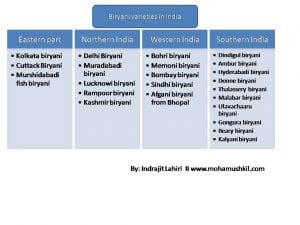
Western India
Hold your breath Bengali ladies and gentlemen all across the globe and please hire a supari killer to kill me. Kolkata is not the only place, where you get potato in Biryani. You get the same in Mumbai, for the Sindhi and Bombay biryani as well. Well, in the Western part, you don’t get much of a difference in the biryanis, but still, let us try to understand them.
Bohri Biryani
AS per my knowledge goes, Bohri cuisine originated from the Shia Muslim community in Yemen, who later traveled largely to western India and Pakistan. Thus there is a strong Gujarati confluence in it as well as an overdose of meat. The cuisine is traditionally served in Thals, a large metal plate. The whole family sits around it and eats from that one plate. It implied unity and equality in the Bohra community. A square cloth called Safra is placed on the carpet, and a raised metal or wooden round called kundali is placed on which the thal is kept. Even on a daily basis, if a dish has been placed on the thal, there must be at least one person seated before it as food must not be ignored and while the other person eats, one can’t get up when done.
Bohri biryani is one of the subtly spiced biryani in India and mutton trotters and gurda are also used along with the meat. Please note, this is my only tryst with Bohri biryani and I am not the champion here. so, if anyone wants to correct me or comment, please feel free to do so in the comment section.
Memoni biryani
Memoni biryani is said to be developed by the Muslim ethnic group named the Memons. Now, this ethnicity has originated from the Sindh region, currently from Pakistan. So naturally, this version of biryani is more towards the Sindhi Biryani- slightly spicy, flavored with green chilies. Chopped tomato and lemon juice are used to impart a typical flavor. I’ve used the famous Shan Spice mix for Memoni biryani and my sole experience is based on multiple usages of the same.
Sindhi and Bombay biryani
Sindhi biryani has originated from the Sindh region and can easily be called as Pakistan’s original biryani. It’s a full-bodied, heavily spiced and sour card, and chilies are heavily used. Definitely this version is not for the weak-hearted persons. Potato is used here along with meat. but so is there in its probable counterpart named Mumbai biryani. Folklore says, a small amount of plum is also put in while making the Bombay Biryani- but I am not really sure of it. Please read about it here in my friend Kalyan Karmakar’s blog post on the same.
Afgani Biryani
Afghani Biryani is known as a variant available in the Bhopal region. There is a good Afgan community there and probably that’s the reason for the specific type. I have not tested it myself, but it’s known to be lightly spiced, subtle, and loaded with dry fruits. But that’s the very typical nature of the Afgan Cuisine. In Kolkata, we had a restaurant named Kabul Kolkata and I was a fan of their Mutton Kabuli Pulao. But like many good things in life, that’s also closed now. However, this part will be updated once I travel to Bhopal myself.
Biryani at Southern India
Though I am a Bengali by birth and Bong by heart, I love the biryanis from South India. And this love goes way deeper than the usual Hyderabadi Biryani. The southern part has always been champion in the ancient spice trade. So, variations from this part use a more complex spice mix. the biryani is moister than the East and North regions. And usually, all across South India, people love to have multiple accompaniments with their Biryani. A watery Raita, Salan, or multiple gravies play their role here. So, let’s start with the varieties.
Dindigul Biryani
Dindigul biryani is the champion of Tamilnadu. Chola, Pandya, and Vijayanagar kingdoms have loved this. A very typical variety of rice is used here, named Jeera Samba. The sourness in the taste, thanks to sour curd and lemon juice marination in the small meat pieces, is what makes it stand out. This variety is a make-or-break thing. Either you love it or hate it.
Ambur Biryani
This variation is also known as Arcot Biryani and is said to be originated from Ambur and Vaniyambdi towns of Vellore district, Tamilnadu. This is also a strong full-bodied biryani. A typical Seeraga Samba rice is used here along with mace and star anise. Instead of one large piece of meat, multiple small pieces are put in. The reason, maybe getting the meat moister.

Hyderabadi Biryani
all hail the king of Biryani in India. By the sheer sales volume, this variety surpasses any other biryani in India by miles. Let me talk on the difference with the Kolkata Biryani. The primary difference between Hyderabadi biryani and Kolkata styled biryani is that the former is a kacchi biryani, wherein Kolkata styled one is a pakki biryani. A kacchi biryani has raw meat layered with rice cooked in 3 stages. And as per the layer, they’re distributed. Some mint leaves are thrown in and use of a heavy masala/ spice is noticed.
The biryani is distinctly different with an emphasis on the aroma of meat. Hence the choice of meat is of primary importance. But, one thing is for sure, subtlety is not really the strength of Hyderabadi Biryani. Rather, they’ve worked on the balance of taste and I love Hyderabadi Biryani for this one thing. I can’t thank my friend blogger Sabyasachi Roychowdhury for his help in understanding the Hyderabadi biryani.
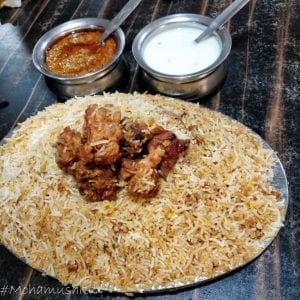
Donne biryani
Well, this is another very interesting variety of Biryani in India. In this list, this is the entrant from Karnataka. Donne technically means a saal leaf container. and this biryani got its name from this. There is a heavy dose of coriander and mint in this biryani and as a result, the color is close to green-ish. I’ve tasted it at multiple places in Bangalore, during my official travel there.
Thalassery and Malabar Biryani
As the name suggests, both these varieties of biryani come from the coastal area Malabar. And while the base is similar, the difference lies in the interesting spice mix and rice quality. It’s said that in ancient days, during the trading days with Mesopotamia/ Arab/ Egypt/ Greece and Rome. Black pepper was called the black gold and one bag of black pepper was traded with the same weight of gold. Heavy usage of black pepper can be found here. Mapppila means son-in-law and this coastal cuisine, born with a marriage between Arabic and Malabar style can be named as Mappila Cuisine.
Thalassery biryani is a pakki biryani, wherein Kozhikode Biryani is Kacchi biryani. Basmati rice is prohibited, as it’s said to overpower the spice magic. Malabar biryani can also be cooked with Seafood or Fish.
Please check the interview of Ummi Abdullah, the queen of Mappila cuisine, shot by yours truly
Ulavacharu and Gongura Biryani
Both these varieties come from the undivided Andhra Pradesh. And if we tend to discuss the Biryani in India, these varieties can’t be left behind. Ulavacharu means a tangy soup made from horse gram, which is a typical love in Andhra. And Gongura is a type of Sorrel leaves grown and loved widely in Telengana and Andhra Pradesh. Naturally, these ingredients are the primary ingredients in preparing these distinct varieties. As per tradition, small pieces of meat are used in both cases. But let me warn, these varieties are not for the lovers of traditional biryani in India. either you love them or hate them. So, proceed at your own risk.
Can we call them as Pulao and not Biryani? Well, not so sure …
Beary Biryani
Beary biryani is also from Karnataka, namely the Mangalore region. And this can be made with either meat or seafood. Instead of the meat, the rice is marinated (if we can call it, that) with ghee and spices and thus landing to a very typical fragrance. I have never tasted this variety myself and can’t really comment on the taste.
Bhatkal Biryani is also a not-so-distant cousin from the coastal Karnataka and is said to have used a lot of green chilly for flavoring
Kalyani Biryani
We can find a clear class division even in biryani in India. If Hyderabadi Dum biryani is for the rich, people with humble means love their Kalyani biryani in Hyderabad. Mostly sold in the hole-in-the-wall joints, this variety of Biryani is primarily made with Buffalo or cow meat, to serve the modest class of society.
The Kalyani nawabs, migrated from Bidar to Hyderabad, were known for their hospitality. And anyone who went visiting them had two rounds of dishes. The same cooks were the ones who started this variation. The other theory says, Kalyani is the codeword for Beef. I am not very sure about the authenticity of either one and please feel free to update me, if you know something. Please read about it in detail here …
Well, this listing pretty much sums up the biryani journey in India. I understand I’ve missed a few but please be assured. They’ll be updated from time to time. And if you have time, please check my experience working with Master Chef Sanjeev Kapoor for his biryani journey
Sanjeev Kapoor, Kolkata Biryani walk and one stupid food blogger
Bon apetit !!!
I can be reached at 9903528225 / indrajit.lahiri@ymail.com




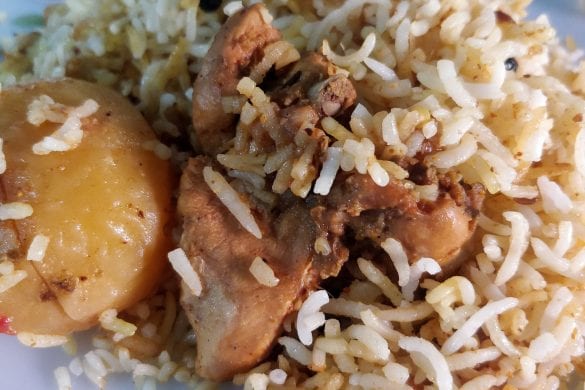


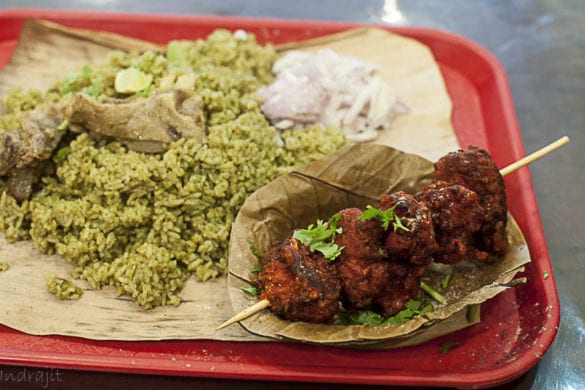
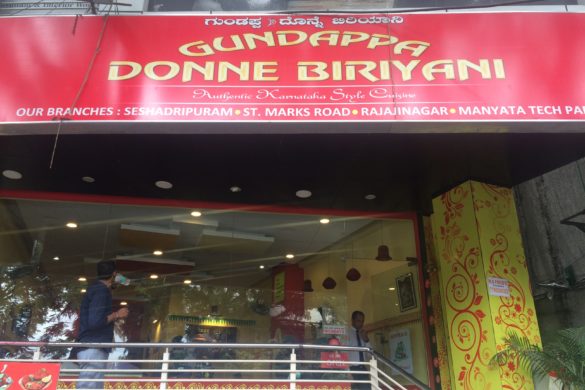
3 comments
It was perfect the first time. I learn so much from you as well! Keep it up great post.
[…] in a little backgrounder on the enigma that biryani is throughout India, these two posts (post 1, post 2) by an ace food blogger have all that you need to […]
[…] Biryani is a sweet-smelling and delightful dish that you should attempt while visiting India. Having said that, every space of the nation has its own take and minor departure from this conventional dish. Some are tart, while others aren’t, yet they’re all worth the difficulty. Here are a portion of the various kinds of the biryanis accessible in India. […]